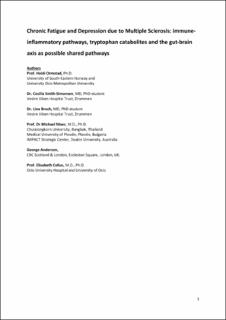| dc.contributor.author | Ormstad, Heidi | |
| dc.contributor.author | Simonsen, Cecilia Smith | |
| dc.contributor.author | Broch, Line | |
| dc.contributor.author | Maes, Dr Michael | |
| dc.contributor.author | Anderson, George | |
| dc.contributor.author | Celius, Elisabeth Gulowsen | |
| dc.date.accessioned | 2020-11-13T12:47:17Z | |
| dc.date.available | 2020-11-13T12:47:17Z | |
| dc.date.created | 2020-10-30T12:40:59Z | |
| dc.date.issued | 2020 | |
| dc.identifier.citation | Ormstad, H., Simonsen, C. S., Broch, L., Maes, M., Anderson, G., & Celius, E. (2020). Chronic Fatigue and Depression due to Multiple Sclerosis: immune-inflammatory pathways, tryptophan catabolites and the gut-brain axis as possible shared pathways. Multiple Sclerosis and Related Disorders, 46, 102533. | en_US |
| dc.identifier.issn | 2211-0348 | |
| dc.identifier.uri | https://hdl.handle.net/11250/2687821 | |
| dc.description.abstract | Chronic fatigue and major depression (MDD)-like symptoms are common manifestations of multiple sclerosis (MS), both with huge impact on quality of life. Depression can manifest itself as fatigue, and depressive symptoms are often mistaken for fatigue, and vice versa. The two conditions are sometimes difficult to differentiate, and their relationship is unclear. Whether chronic fatigue and depression occur primarily, secondarily or coincidentally with activated immune-inflammatory pathways in MS is still under debate. We have carried out a descriptive review aiming to gain a deeper understanding of the relationship between chronic fatigue and depression in MS, and the shared pathways that underpin both conditions. This review focuses on immune-inflammatory pathways, the kynurenine pathway and the gut-brain axis. It seems likely that proinflammatory cytokines, tryptophan catabolites (the KYN pathway) and the gut-brain axis are involved in the mechanisms causing chronic fatigue and MDD-like symptoms in MS. However, the evidence base is weak, and more research is needed. In order to advance our understanding of the underlying pathological mechanisms, MS-related fatigue and depression should be examined using a longitudinal design and both immune-inflammatory and KYN pathway biomarkers should be measured, relevant clinical characteristics judiciously registered, and self-report instruments for both fatigue and depression should be used. | en_US |
| dc.language.iso | eng | en_US |
| dc.rights | Attribution-NonCommercial-NoDerivatives 4.0 Internasjonal | * |
| dc.rights.uri | http://creativecommons.org/licenses/by-nc-nd/4.0/deed.no | * |
| dc.title | Chronic fatigue and depression due to multiple sclerosis: Immune-inflammatory pathways, tryptophan catabolites and the gut-brain axis as possible shared pathways | en_US |
| dc.type | Peer reviewed | en_US |
| dc.type | Journal article | en_US |
| dc.description.version | acceptedVersion | en_US |
| dc.rights.holder | © 2020 Published by Elsevier B.V. | en_US |
| dc.source.volume | 46 | en_US |
| dc.source.journal | Multiple Sclerosis and Related Disorders | en_US |
| dc.identifier.doi | https://doi.org/10.1016/j.msard.2020.102533 | |
| dc.identifier.cristin | 1843602 | |
| dc.source.articlenumber | 102533 | en_US |
| cristin.ispublished | true | |
| cristin.fulltext | original | |
| cristin.qualitycode | 1 | |

